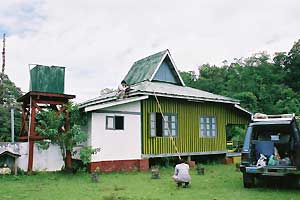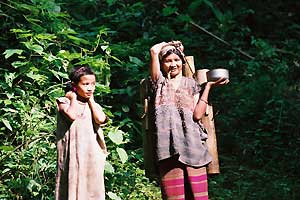| Period: 20 July - 6 August 2003. Country: Myanmar, Laos |
| |
Purpose of the Visit |
| |
On-Site Education and Joint Research in Myanmar and Laos |
| |
TAKEDA Shinya (ASAFAS: Division of Southeast Asian Area Studies) |
| |
Record of Activities |
| |
7/20 (Sun) |
 |
Kyoto – Yangon |
| |
7/21 (Mon) |
 |
Yangon – Pyay: Meeting with the Forest Department |
| |
7/22 (Tue) – 24 (Thu) |
 |
Stay at Paukkhaung Camp, survey SN Village |
| |
7/25 (Fri) |
 |
Pyay – Nyaunpintha – Taungtwingy – Moeschwe – Yezin |
| |
7/26 (Sat) |
 |
Yezin – Toungoo: Meeting with Institute of Forestry |
| |
7/27 (Sun) – 28 (Mon) |
 |
Survey in area around Kyetshar |
| |
7/29 (Tue) |
 |
Toungoo – Bawnetgyi – Bago – Yangon |
| |
7/30 (Wed) – 8/2 (Sat) |
 |
Yangon: Meeting with the Forest Department; Local seminar at the Yangon FS |
| |
8/3 (Sun) |
 |
Yangon – Bangkok |
| |
8/4 (Mon) |
 |
Bangkok – Vientiane |
| |
8/5 (Tue) |
 |
Meeting and local seminar at the National University of Laos,
Faculty of Agriculture and Forestry |
| |
8/6 (Wed) |
 |
Vientiane – Kyoto |
| |
Outcome
and Progress Report |
| |
- (1) On-Site Education in Myanmar
- On this trip,
I visited the survey area in the Bago mountain range, along with Reiji Suzuki(Year
of admission into the 3rd year: 2001) and Yuki Onodera(Year of enrollment:
2003). Suzuki has set his research theme as the “Long-term Sustainability of Taungya Teak Reforestation viewed
from transition of environmental factors in the Bago Mountain Range, Myanmar
.” He conducted long-term research in the area during the last fiscal
year, and this time carried out a supplementary survey. The great advantage
of “on-site education” is that it allows us to have discussions
on the site.
- (2) Joint Research in Myanmar
- Joint research is being carried out on forest use in the Bago mountain
range. Teak plantations were established in the middle of the 19th century
in the Bago mountain range, and have continued until today. There are very
few examples outside of the Bago range where plantation has been conducted
for such a long period of time in a tropical region. In order to gain a
general understanding of the experience of this forest, studies are being
implemented jointly with the Myanmar Institute of Forestry (Grant-in-Aid
for Scientific Research, Scientific Research [B], “Sustainable Forest
Management and indigenous uses of forest resources in Myanmar”).
Along with ongoing surveys in the Kabaung River basin on vegetation, soil,
land use and plant use, weather monitoring and dendrochronological studies
were initiated at seven sites in the Bago mountain range. The following
is included in the mid-term report for joint research for the current fiscal
year.
- Reiji Suzuki, Shinya Takeda, 2003, “Long-term sustainability of “taungya” teak
reforestation Myanmar: focusing on the effects of forest fires on the long-term
dynamics of soil organic matter” The Proceedings of 13th Conference
of Japan Society of Tropical Ecology, p. 62
- Maki Fukushima, Mamoru Kanzaki, Seiichi Ota, Shinya Takeda, 2003, “Forest
recovery after shifting cultivation of the Karen People in Myanmar,” The
Proceedings of 13th Conference of Japan Society of Tropical Ecology,
p. 63
- Yukino Ochiai, 2003, “Use of plants from the Coix lacryma-jobi L.
(Job's tears) variety by the Karen: from the case of SN Village in the Bago
Division, Myanmar,” The Proceedings of 13th Conference of Japan Society
of Tropical Ecology, p. 64
- Shinya Takeda, Reiji Suzuki, San Lwin, Hla Maun Thein, 2003, “Mapping
Shifting Cultivation Fields in Karen Area, Bago Yoma, Myanmar,” Japanese
Journal of Tropical Agriculture Vol.47 (Extra Issue 2), pp. 81-82
- Reiji Suzuki, Shinya Takeda, San Lwin, Hla Maun Thein, 2003, “Agroforestry
in Myanmar: Soil nutrient dynamics under Taungya system during intercropping
period,” Japanese Journal of Tropical Agriculture Vol.47 (Extra Issue
2), pp. 83-84
- (3) On-Site Education in Laos
- A seminar was held at the Field Station of this Program, which was opened in the National University of Laos. For its detail, please see Iwata's report.
|
| |
Future Tasks |
| |
One of the future tasks is risk management at the survey
site including malaria.
The Paukkhaung camp, where we stayed for a short period, is in a site well
known for malaria in the Bago mountain range. Because of this, a lot of
attention was given to anti-mosquito measures, such as mosquito coils,
insect spray and mosquito nets, but Suzuki contracted malaria and had to
be hospitalized soon after arriving back in Japan. Fortunately, his case
was not serious, but he contracted the disease twice in the space of one
year.
This was a painful reminder of the fact that we must equip ourselves with
adequate knowledge, and bring the necessary medications with us. |
 |
|
 |
| Calibrating the rainfall
meter installed on the roof of the dormitory (Kyetsha) |
|
Carrying
water from a stream in bamboo pipes (SN Village) |
|
|
 Report
Report